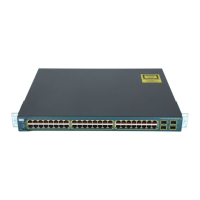31-10
Catalyst 3560 Switch Software Configuration Guide
78-16156-01
Chapter 31 Configuring HSRP
Displaying HSRP Configurations
This example shows how to bind standby group my_hsrp to the cluster and enable the same HSRP group
to be used for command switch redundancy and router redundancy. The command can only be executed
on the cluster command switch. If the standby group name or number does not exist, or if the switch is
a cluster member switch, an error message appears.
Switch# configure terminal
Switch(config)# cluster standby-group my_hsrp routing-redundancy
Switch(config)# end
Displaying HSRP Configurations
From privileged EXEC mode, use this command to display HSRP settings:
show standby [interface-id [group]] [brief] [detail]
You can display HSRP information for the whole switch, for a specific interface, for an HSRP group, or
for an HSRP group on an interface. You can also specify whether to display a concise overview of HSRP
information or detailed HSRP information. The default display is detail. If there are a large number of
HSRP groups, using the show standby command without qualifiers can result in an unwieldy display.
This is a an example of output from the show standby privileged EXEC command, displaying HSRP
information for two standby groups (group 1 and group 100):
Switch# show standby
VLAN1 - Group 1
Local state is Standby, priority 105, may preempt
Hellotime 3 holdtime 10
Next hello sent in 00:00:02.182
Hot standby IP address is 10.0.0.1 configured
Active router is 172.20.138.35 expires in 00:00:09
Standby router is local
Standby virtual mac address is 0000.0c07.ac01
Name is bbb
VLAN1 - Group 100
Local state is Active, priority 105, may preempt
Hellotime 3 holdtime 10
Next hello sent in 00:00:02.262
Hot standby IP address is 172.20.138.51 configured
Active router is local
Standby router is unknown expired
Standby virtual mac address is 0000.0c07.ac64
Name is test

